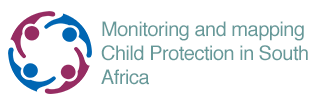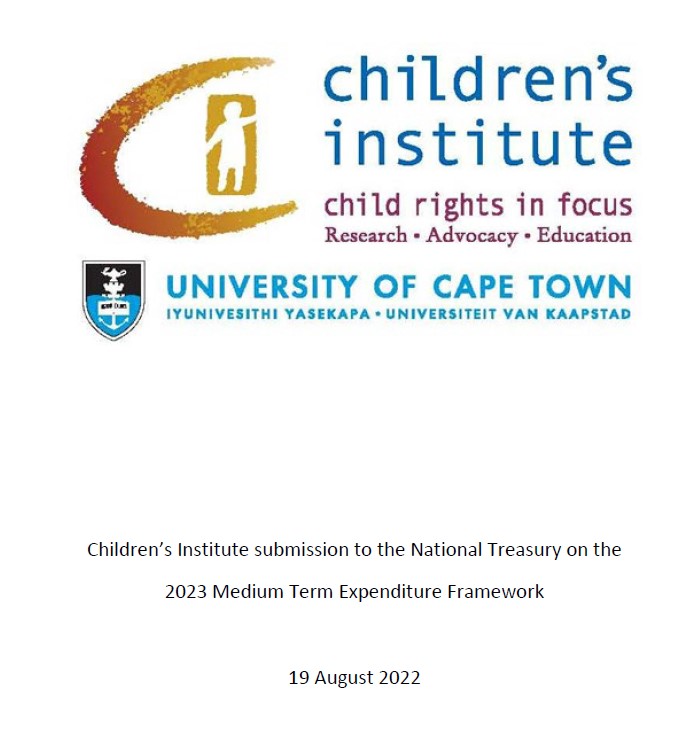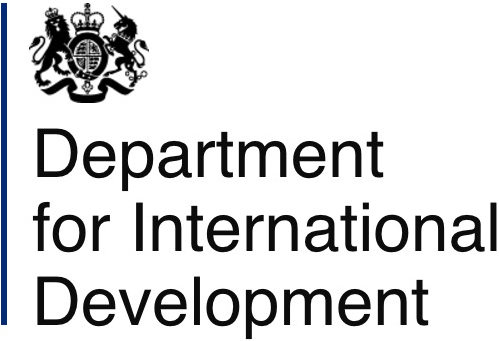This indicator shows the number and percentage of children who have access to a safe and reliable supply of drinking water at home – either inside the dwelling or on site. A piped water connection is used as a proxy for access to adequate water. All other water sources, including public taps, water tankers, dams and rivers, are considered inadequate because of their distance from the dwelling or the possibility that water is of poor quality or erratic in its supply. The indicator does not show whether the water supply is reliable or if households have broken facilities or are unable to pay for services.
Analysis by Katharine Hall & Sumaiyah Hendricks, Children’s Institute, University of Cape Town.
- Children are defined as persons aged 0 – 17 years.
- Population numbers have been rounded off to the nearest thousand.
- Sample surveys are always subject to error, and the proportions simply reflect the mid-point of a possible range. The confidence intervals (CIs) indicate the reliability of the estimate at the 95% level. This means that, if independent samples were repeatedly taken from the same population, we would expect the proportion to lie between upper and lower bounds of the CI 95% of the time. The wider the CI, the more uncertain the proportion. Where CIs overlap for different sub-populations or time periods we cannot be sure that there is a real difference in the proportion, even if the mid-point proportions differ. CIs are represented in the bar graphs by lines at the top of each bar.
Section 27 (1)(b) of the Constitution of South Africa provides that “everyone has the right to have access to … sufficient … water” and section 24 (a) states that “everyone has the right to an environment that is not harmful to their health or well-being”.[1]
Article 24 (1)(c) of the United Nations (UN) Convention on the Rights of the Child says that state parties should “recognise the right of the child to the enjoyment of the highest attainable standard of health” and to this end should “take appropriate measures to combat disease and malnutrition …, including the provision of clean drinking-water”.[3]
Clean water is essential for human survival. The World Health Organisation defined “reasonable access” to water as being a minimum of 20 litres per person per day.[4] The 20-litre minimum is linked to the estimated average consumption when people rely on communal facilities and need to carry their own water for drinking, cooking, handwashing and face washing. It does not allow for other hygiene practices like bathing showering, washing clothes or domestic cleaning. This “basic” level of water access is still considered high risk for health outcomes. A higher “intermediate” level of access with “medium” risk is around 50 litres per person per day, delivered to the site or within a five-minute walk. “Optimal” access (low risk) is defined as a minimum of 100 litres per person per day, supplied through on-site taps and continuously available.[5] Adequacy therefore refers to quantity, quality and accessibility: the water needs to be supplied close to home, as households that travel long distances to collect water often struggle to meet their basic daily quota. This can compromise children’s health and hygiene.
The Sustainable Development Goals (in target 6.1) call for universal and equitable access to safe and affordable drinking water, and this is defined as a safely managed drinking water service from an improved water source that is located on premises.
Young children are particularly vulnerable to diseases associated with poor water quality. Gastro-intestinal infections with associated diarrhoea and dehydration are a significant contributor to the high child mortality rate in South Africa,[6] and intermittent outbreaks of cholera in some provinces pose a serious threat to children. Lack of access to adequate water is closely related to poor sanitation and hygiene. In addition, children may be responsible for fetching and carrying water to their homes from communal taps, or rivers and streams. Carrying water is a physical burden that can lead to back problems or injury from falls. It can also reduce time spent on education and other activities and can place children at personal risk.[7] This child-centred indicator of adequate water is therefore set at a slightly higher standard than the definition of basic water in South Africa, as it requires a water source on site (either inside the house or in the yard of the household where the child lives).
The share of children with piped water at home increased from 60% in 2002 to 70% nationally in 2017, representing an increase of three million children. The biggest improvements over this period were in the Eastern Cape (from 24% to 40%) and KwaZulu-Natal (from 46% to 60%).
After the overall improvements in access to adequate water between 2002 and 2017, the trend levelled off, suggesting that a ceiling had been reached. In 2024, 73% of children were living in households with piped water, while over a quarter (nearly 6 million children) depended on water connections that were off-site or did not meet the adequacy standard of providing a safe, reliable supply. Adults are more likely than children to live in households with adequate water access (80% of adults compared with only 73% of children). This is because, compared with the adult population, children are more likely to live in rural households located in areas without bulk service infrastructure.
Over 90% of children living in urban areas have water on site, compared with 43% of children in the rural former homelands and 61% of children living on farms. While the majority (78%) of children in formal dwellings have access to an adequate water supply on-site, this decreases to 66% for children living in informal dwellings. Only 21% of the 1.6 million children living in traditional dwellings have water available on the property.
The vast majority of children living in the former homelands and in traditional dwellings are African, so there is also pronounced racial inequality in access to water. In 2024, 69% of African children had water on site, while levels of piped water access for all other population groups exceeded 95%. There are no significant differences in access to water across age groups.
Provincial differences are striking. Around nine of out of ten children in Gauteng (96%), the Western Cape (93%) and the Free State (89%) have piped water at their home. All of these provinces started from a high base in terms of water access, and there has not been significant change over the past two decades. The provinces that have experienced substantial improvements in water provision are those which had the lowest levels of access to start with: the Eastern Cape (a significant improvement in the provincial share of children with water on site, from 24% in 2002 to 42% in 2024), KwaZulu-Natal (from 46% to 61%); Limpopo (a more modest improvement from 45% to 53%) and Mpumalanga (from 71% to 77%). The Eastern Cape, with its large under-serviced former homeland areas, remains the only province in which more than half of all children do not have piped water to their home, while water access in the Northern Cape seems to be declining.
Inequality in access to safe water is also pronounced when the data are disaggregated by income group. Only 57% of children in the poorest 20% of households have access to water on site, while 98% of those in the richest 20% of households have this level of service. In this way, inequalities are reinforced: the poorest children are most at risk of diseases associated with poor water quality and the associated setbacks in their development.
The GHS uses a Master Sample frame which has been developed as a general-purpose household survey frame that can be used by all other Stats SA household-based surveys that have design requirements that are reasonably compatible with the GHS. The sample is drawn from Census enumeration areas using a stratified two-stage design with probability proportional to size sampling of PSUs in teh first stage, and sampling of dwelling units with systematic sampling in the second stage. The resulting sample consists of just over 20,000 households with around 70,000 individuals, and should be representative of all households in South Africa. It is also designed to be representative at provincial level and within provinces at metro/non-metro levels and three geography types (urban areas, rural areas under traditional authority, and farms).
The sample consists of households and does not cover other collective institutionalised living-quarters such as boarding schools, orphanages, students’ hostels, old-age homes, hospitals, prisons, military barracks and workers’ hostels. These exclusions probably do not have a noticeable impact on the findings in respect of children.
Changes in sample frame and stratification
Since 2014 the GHS has been based on the 2013 master sample that that is, in turn, based on information collected during the 2011 Population Census. The previous master sample for the GHS was used for the first time in 2008, and the one before that in 2004. These again differed from the master sample used in the first two years of the GHS: 2002 and 2003. Thus there have been four different sampling frames during history of the annual GHS, with the changes occurring in 2004, 2008 and 2013. In addition, there have been changes in the method of stratification over the years. These changes could compromise comparability across iterations of the survey to some extent, although it is common practice to use the GHS for longitudinal monitoring and many of the official trend analyses are drawn from this survey.
Weights
Person and household weights are provided by Stats SA and are applied in Children Count analyses to give population estimates on the indicators. The GHS weights are derived from Stats SA’s mid-year population estimates for the relevant year. The population estimates are based on a model that is revised from time to time when it is possible to calibrate the population model to Census data and larger population surveys such as the Community Survey.
In 2017, Stats SA revised its demographic model to produce a new series of mid-year population estimates and the GHS data were re-released with the revised population weights. All the Children Count indicators were re-analysed retrospectively, using the revised weights provided by Stats SA, based on the 2013 model. The estimates are therefore comparable over all years. The revised weights particularly affected estimates for the years 2002 – 2007.
The 2017 model drew on the 2011 census, along with vital registration, antenatal and other administrative data, but was a “smoothed” model that did not mimic the unusual shape of the age distribution found in the census. The results of the 2011 census were initially distrusted because it seemed to over-count children in the 0 – 4 age group and under-count children in the 4 – 14-year group. It is now thought that the fertility rates recorded in the 2011 population census may have been an accurate reflection of demopraphic trends, with an unexplained upswing in fertility around 2009 after which fertility rates declined again gradually. Similar patterns were found in the vital registration data as more births were reported retrospectively to the Department of Home Affairs, and in administrative data from schools, compiled by the Department of Basic Education. In effect, this means that there may be more children in South Africa than appear from the analyses presented in these analyses, where we have applied weights based on a model that it is now known to be inaccurate.
Stats SA has subsequently developed a new population model - the 2022 series, which provides revised mid-year population estimates back to 2002 and projected to 2032. However, the GHS series has not yet been reweighted.The population estimates in Children Count are therefore based on weights derived from outdated population model (2017). It is not yet clear when and how the population model will be revised again following the 2022 Census, as there are concerns around census under-count and plausibility of its findings.
Disaggregation
Statistics South Africa suggests caution when attempting to interpret data generated at low level disaggregation. The population estimates are benchmarked at the national level in terms of age, sex and population group while at provincial level, benchmarking is by population group only. This could mean that estimates derived from any further disaggregation of the provincial data below the population group may not be robust enough.
Reporting error
Error may be present due to the methodology used, i.e. the questionnaire is administered to only one respondent in the household who is expected to provide information about all other members of the household. Not all respondents will have accurate information about all children in the household. In instances where the respondent did not or could not provide an answer, this was recorded as “unspecified” (no response) or “don’t know” (the respondent stated that they didn’t know the answer).
For more information on the methods of the General Household Survey, see the metadata for the respective survey years, available on Nesstar or DataFirst






 The SAECR 2024 tracks trends on the status of children under 6.
The SAECR 2024 tracks trends on the status of children under 6. 








